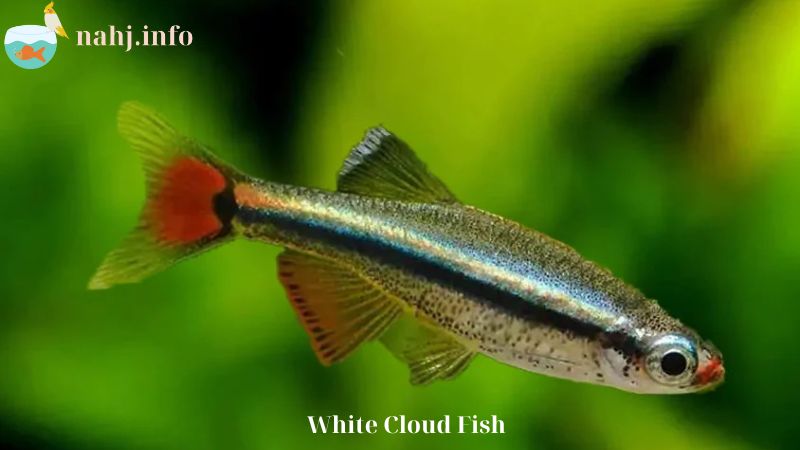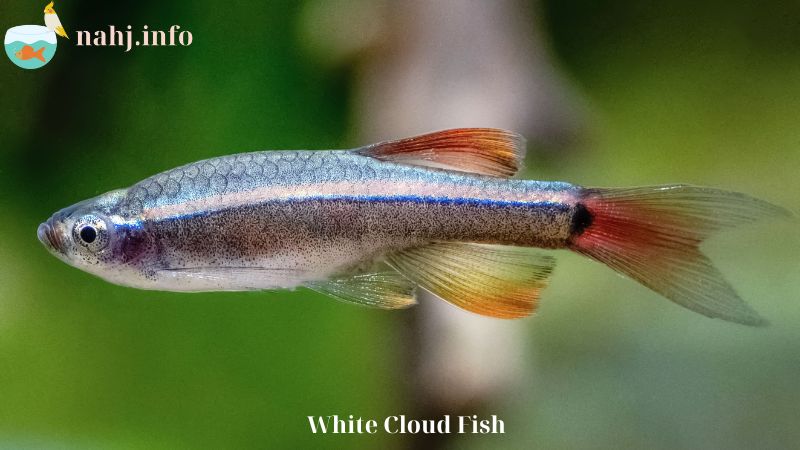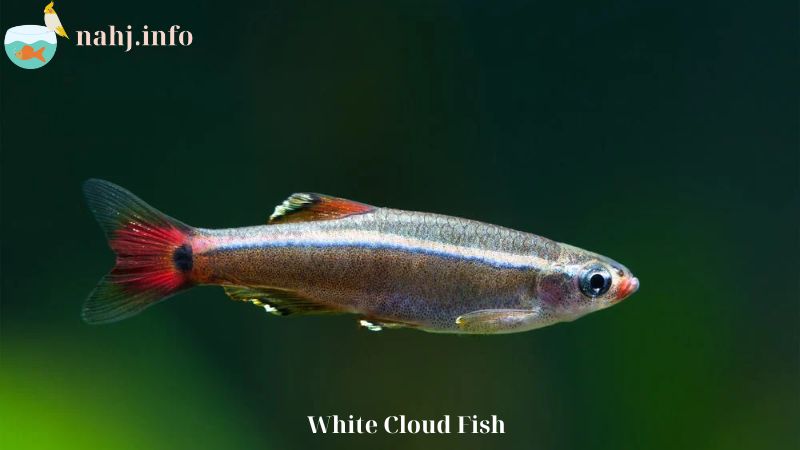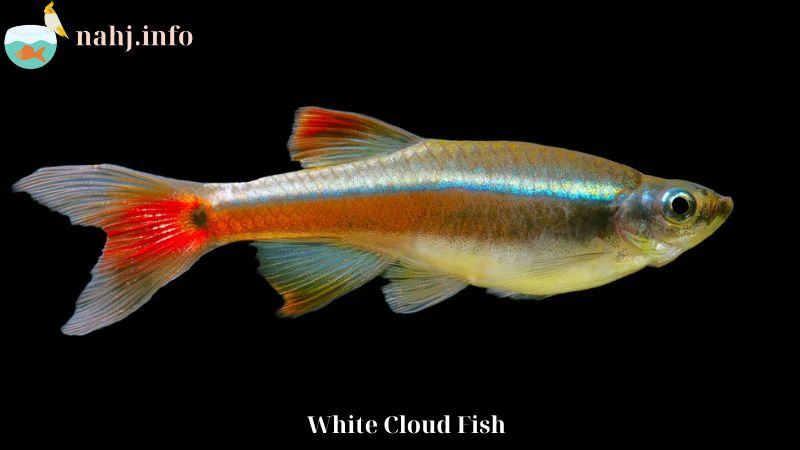The White Cloud Fish is one of the most popular aquarium fish in freshwater aquariums. With its graceful beauty and ease of care, the White Cloud Mountain Minnow is not only attractive to beginners but also a favorite choice of many veteran aquarium keepers. This article, nahj.info will provide detailed information about the White Cloud Mountain Minnow, from its biological characteristics, habitat, care, to common diseases and prevention.
1. Introduction to White Cloud Mountain Minnow
a. Origin and Characteristics
The White Cloud Mountain Minnow originates from the mountain ranges of China, especially the lakes and streams in the highlands. This fish belongs to the carp family (Cyprinidae) and is known for its ability to survive well in cold water environments. The scientific name of the White Cloud Mountain Minnow is Tanichthys albonubes, and its common name comes from the color characteristics of the fish’s body.
b. Appearance
White Cloudfish are small in size, usually only reaching about 4-5 cm when mature. They stand out with their main color being bright white, often with a red or orange stripe running from head to tail. The fins are slender and transparent, creating a graceful and elegant beauty. White Cloudfish can live from 3 to 5 years if well cared for.
2. Living Environment and Fish Raising Conditions

a. Choosing a Fish Tank
White Cloudfish need a tank with a minimum size of 40 liters to give them space to swim comfortably. The tank should have a lid because this fish can jump out. Make sure the tank has an effective water filtration system to maintain a clean and stable water environment.
b. Water Conditions
White Cloudfish prefer cold water, the ideal temperature for them is from 18-22°C. The water in the tank should be changed regularly and checked for important parameters such as pH (6.5-7.5), ammonia, nitrite and nitrate. White Cloudfish can tolerate a wide range of pH levels, but maintaining a stable pH level is important.
c. Plants and Decorations
White Cloudfish prefer an environment with plenty of aquatic plants and decorations. Plants such as Java Fern, Anubias and Moss Balls are good choices. These elements not only beautify the aquarium but also provide hiding places and reduce stress for the fish.
3. Diet
a. Food Types
White Cloudfish are omnivorous and can consume a variety of foods, from pellets, frozen foods such as artemia, to live foods such as bloodworms. To ensure that your fish have a complete diet, provide them with a varied and balanced diet.
b. Feeding Schedule
White Cloudfish should be fed 2-3 times a day, each time in a small amount that they can finish in about 2-3 minutes. Avoid overfeeding to avoid polluting the water and reducing the risk of health problems.
4. White Cloudfish Care

a. Regular Water Changes
Regular water changes are important to maintain the water quality in your aquarium. You should change about 25-30% of the water in your tank each week. When changing the water, use dechlorinated water that is the same temperature as the water in your tank to avoid shocking your fish.
b. Checking Water Quality
Checking water quality is necessary to ensure that your White Cloudfish is in the best possible condition. You should check the pH, ammonia, nitrite, and nitrate levels regularly to ensure they are at safe levels.
c. Fish Health Observation
Observe your White Cloudfish daily to detect early signs of disease. Healthy fish will have bright colors, swim flexibly and have no signs of disease such as white spots, torn fins or abnormal behavior.
5. Common Diseases and How to Prevent Them
a. Fungal Disease
Fungal diseases often appear as white spots on the body and fins of the fish. To prevent fungal diseases, you need to maintain a clean water environment, change the water regularly and check the water quality regularly. If the fish is infected with fungus, you can use antifungal medicine and increase the water temperature to about 22-24°C.
b. Scale Rot
Scale rot causes the fish’s scales to fall off and the fish’s body to become ulcerated. The main cause is polluted water or trauma. To prevent it, maintain a clean living environment, and if signs of disease are detected, treat it promptly with specialized medicine.
c. Fin Rot
Fin rot causes the fish’s fins to rot and lose color. To prevent this disease, make sure the water environment is always clean and provide a balanced diet. If the fish has fin rot, change the water regularly and use fin rot medication as directed by your veterinarian.
6. Breeding White Cloud Fish

a. Preparing for Breeding
White Cloud Fish can breed easily in an aquarium. To stimulate breeding, you need to provide an ideal environment with stable water temperature, aquatic plants and a nutritious diet. White Cloud Fish usually breed in the summer and need special care to ensure the fry develop healthily.
b. Breeding Process
When White Cloud Fish start to breed, they will create a bubble nest on the surface of the water. The female will lay eggs in the bubble nest and the male will fertilize them. After the eggs hatch, the fry will be cared for by the male in the bubble nest until they are able to swim out.
c. Caring for Baby Fish
Baby fish need special care in the early stages. Provide them with suitable food such as nauplii artemia and ensure the water environment is always clean and stable. Make sure the baby fish have enough space to grow and are not stressed.
7. Experience in Raising White Cloud Fish
a. Choosing the Same Species
White Cloud Fish are sociable fish and can be kept with many other fish species. However, you should avoid keeping them with large or aggressive fish to avoid conflicts. Fish of the same size and gentle personality such as guppies and tetras are good choices.
b. Monitoring Behavior
Observing the behavior of White Cloud Fish is very important to detect health problems early. White Cloud Fish usually swim in schools and are very active. If you see abnormal signs such as irregular swimming, not eating or signs of illness, check and treat them promptly.
c. Learn More About Fish
Learn more about White Cloud Fish from reliable sources such as books, fishkeeping forums, and experts. Having a good understanding of this fish will help you take better care of them and enjoy the joy of keeping fish.
Conclusion
White Cloud Fish is a wonderful ornamental fish with elegant beauty and easy care. Understanding the necessary factors to raise White Cloud Fish, from living conditions, diet to daily care will help you have a beautiful and healthy aquarium. Hopefully this article has provided you with useful and necessary information to effectively raise White Cloud Fish

